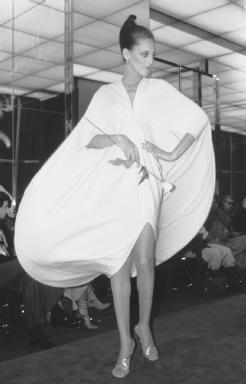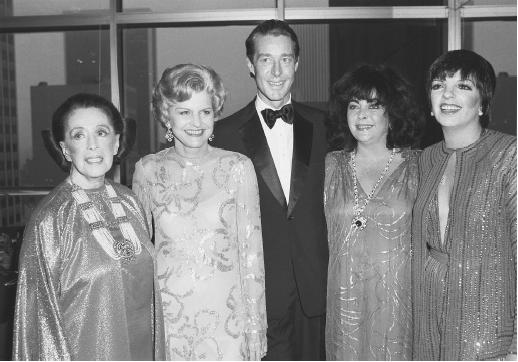HALSTON - Fashion Designer Encyclopedia
American designer
Born: Roy Halston Frowick in Des Moines, Iowa, 23 April 1932. Education: Studied at Indiana University, Bloomington, and at the Art Institute of Chicago to 1953. Career: Freelance milliner, Chicago, 1952-53; window dresser, Carson Pirie Scott, Chicago, 1954-57; designer and hats division manager, Lilly Daché, New York, 1958-59;

Publications
On HALSTON:
Books
Milbank, Caroline Rennolds, Couture: The Great Designers, New York, 1985.
Gaines, Steven, Simply Halston: The Untold Story, New York, 1991,1993.
Rottman, Fred and Elaine Gross, Halston: An American Original, New York & London, 1999.
Bluttal, Steven, and Patricia, Halston, London, 2001.
Articles
"The Private World of Halston," in Harper's Bazaar (New York), February 1973.
Bowles, J., "Will Halston Take Over the World?" in Esquire, August 1975.
Lemann, N., "The Halstonization of America," in Washington Monthly (Washington, D.C.), July 1978.
Belkin, Lisa, "The Prisoner of Seventh Avenue," in the New York Times Magazine, 15 March 1987.

Darnton, Nina, "The Inimitable Halston: The Legendary Designer Breaks the Silence on his Current Dilemma," in Newsweek, 7 August 1989.
Morris, Bernadine, "Halston, Symbol of Fashion in America in the 1970s," [obituary] in the New York Times, 28 March 1990.
"Halston: An American Original," [obituary] in WWD, 28 March 1990.
Mulvagh, Jane, "Halston," [obituary] in the Independent (London), 29 March 1990.
"Hat Man: Halston," [obituary] in U.S. News & World Report, 9 April 1990.
Sporkin, Elizabeth, "The Great Halston," [obituary] in People, 9 April 1990.
Brady, James, "A Prince of the Captivity," in Advertising Age, 16 April 1990.
"Halston," [obituary] in Current Biography, May 1990.
Minnelli, Liza, and Polly Mellen, "Halston: 1932-1990," in Vogue, July 1990.
Gaines, Steven, "The Man Who Sold His Name," in Vanity Fair, September 1991.
"Halston: Modernist Master," in Connoisseur (New York), November 1991.
Hoppe, Karen, "Halston Borghese: Revamping, Retrenching, Revitalized," in Drug & Cosmetic Industry, December 1994.
Born, Pete, "Halston Borghese Seeks a Partner," in WWD, 14 July 1995.
Fine, Jenny B., "Halston Borghese being Sold," in WWD, 19 January 1996.
"French Fragrances Purchasing Four Halston Borghese Scent Brands," in WWD, 13 February 1996.
Lockwood, Lisa, "Halston: Classic Comeback," in WWD, 30 August 1996.
Pagoda, Dianne M., "Halston Taps Duke for Top Design Post," in WWD, 24 September 1996.
D'Innocenzio, Anne, "The Halston Blitz," in WWD, 26 March 1997.
Gault, Ylonda, "…Halston's Back and Trying to Convert Men," in Crain's New York Business, 19 January 1998.
D'Innocenzio, Anne, "Catterton Signs Deal for Halston," in WWD, 28 April 1998.
Gault, Ylonda, "Halston's New Owner Tries to Re-Revive Brand," in Crain's New York Business, 25 May 1998.
Young, Vicki M., "Duke Sues Halston for Breach of Contract," in WWD, 15 July 1998.
D'Innocenzio, Anne, "Halston in Deal with Sinolink to Produce Its Signature Line," in WWD, 14 May 1999.
—, "Halston Rehires Kevan Hall," in WWD, 17 July 1999.
—, "Halston Assets Acquired by Neema," in WWD, 6 December 1999.
McCants, Leonard, "Halston Sets Designer Line for Fall," in WWD, 14 November 2000.
"Guise and Dolls," in WWD, 24 September 2001.
Braunstein, Peter, "Obsessed with Halston," in WWD, 12 October 2001.
* * *
The life of Roy Halston Frowick was marked by deeply American directness. He was known internationally, and in a nonchalant elegance that stripped away all that was superfluous in his life and art, Halston was the creation of his own obsessive, workaholic achievements. In the 1970s and early 1980s Halston was not only the supreme American fashion designer, but the quintessential one.
Again and again, Halston would say to the press, as he told Eugenia Sheppard in the New York Post (7 February 1973), "Women make fashion. Designers suggest, but it's what women do with the clothes that does the trick." While this modest disavowal was in part canny public relations, granting to the client or potential client the creativity of dress, Halston believed his statement. He recognized and accounted for the women who would wear the clothing as much as for his own creation and acknowledged a partnership between designer and wearer. One aspect of the partnership was Halston's continuous synergy with important clients, beginning with his millinery work which, after all, started from the top to reconcile personal attitude and physiognomy with apparel.
Later in his career, as he strove to be the "total designer," Halston's personal affection for and connections to clients in show business, design, dance, and public life gave him an intimate and abiding affiliation with the wearer. And when he sought to dress every woman, there was a grounded, natural aspect to Halston that readily reminded the wearer this cryptically simple designer was born in Des Moines, Iowa and raised in Evansville, Indiana.
If Halston ascribed the social function to the wearer, he himself was the consummate creator of the garment in formal terms and his work corresponded to the minimalism in American arts. His geometry of design, employing bias as the three-dimensional element causing the geometry to drape splendidly on the body, was as conceptual as that of Vionnet. Some design problems were played out in paper origami, as he created twisted forms in white paper on a black lacquer tray. Discovering such form, Halston projected it onto the body with absolute integrity, cutting as little as possible, and allowing the simplicity of the two-dimensional design to be felt, even as it assumed form on the body.
Likewise Halston's colors were as selective as Mondrian's, preferring ivory, black, and red, but knowing that fuchsia, electric blue, or deep burgundy could provide accent and emphasis. Of textiles, he worked with cashmere, silk and rayon jerseys, double-faced wools, and Ultrasuede. His machine-washable Ultrasuede shirtwaist, which sold 60,000 copies, was one of the most popular dresses in America in the 1970s—in its utmost simplicity, the same dress could be worn in a multitude of ways to allow each woman to wear it in her own personal style. His rich double-faced wool coats were the luxury of color fields, an art brought to apparel; his athletic looks in bodysuits and sports-inspired dressing were as much an ancipation of the late 1980s American fashion as they were renewals of 1940s and 1950s Claire McCardell. He could dress a Martha Graham dancer as readily as he could create a mass-market dress.
Halston's eveningwear was acclaimed for its glittery, gossamer shimmer, but often unacknowledged for the same principles of simplicity. Working on the bias, Halston caressed the body with spiralling scarfs of form. His one-piece, held-at-the-shoulder "orange-peel" dress was the product of a deft hand, like that of the fruit peeler. His evening jackets were often nothing more than rings of material twisted into cocoon fantasies. As Liza Minnelli has said of Halston, he made one feel comfortable and feel beautiful.
Merging the special chic of a custom business and a vast ambition to dress everyone in the world was Halston's high goal, briefly achieved in the late 1970s and early 1980s. But business changes ignited the American Icarus' wings and he plummeted to earth, having lost most his empire and the ability to do what was most precious to him—designing. His company was bought and sold numerous times before his death in 1990, and in 1992 was acquired by Saudi businessmen who combined it with the Borghese fragrances to become Halston Borghese Inc.
New fragrances bearing the Halston name were introduced in 1994 and 1995, but the name and its legacy languished until the company was dismantled in 1996. French Fragrances Inc. bought the Halston scents; Tropic Tex Apparel bought the remainder of the Halston's products. "We wanted to bring Halston to the next millennium," Carmine Porcelli, Halson's new director of licensing, told WWD (30 August 1996). To support the reintroduction of the Halston brand and image, Tropic Tex launched a major advertising campaign and brought Randolph Duke on board as creative director.
Over the next few years, the Halston name was licensed for beds and linens, scarves, belts, handbags, hosiery, sunglasses, jewelry, timepieces, leather apparel, sleepwear, and foundations. In the capable hands of Duke, Halston Signature womenswear regained much of its cachet—trunk shows at Bergdorf Goodman and Saks Fifth Avenue sold over $200,000-worth of couture in a few days in 1997. A menswear launch, however, was not as successful and the overexposure in licensing caught up with Tropic Tex. After experiencing financial difficulties, Tropic Tex agreed to sell Halston International to the Connecticut-based Catterton Group in April 1998.
Halston's new owners fired Duke and hired Kevan Hall, who had worked there briefly earlier in the year and abruptly left. Yet by 1999 Catterton had sold Halston's assets to Neema Clothing Ltd., which then hired Craig Natiello as design director. A new Halston Signature menswear line debuted in 2001 after a series of delays, and Natiello had settled in with his womenswear designs. Women's Wear Daily (24 September 2001) commented, "After some rough going, designer Craig Natiello seems to be refining his vision at Halston. While still sexy and amply embellished, his spring collection has a newly controlled feeling, expressed in short, delicately beaded layered dresses, printed chiffon gowns and long skirts."
While the Halston brand spun out of control during the designer's lifetime, it was nothing compared to after his death. In the 21st century, however, the name Halston was again conjured up images of elegance and luxury in womenswear was emerging in menswear as well.
—Richard Martin
Sydonie Benét
Comment about this article, ask questions, or add new information about this topic: